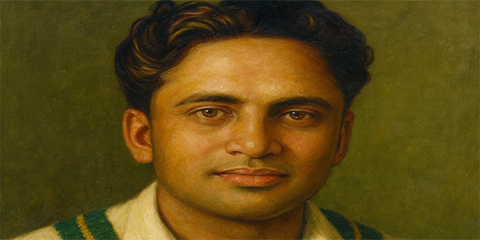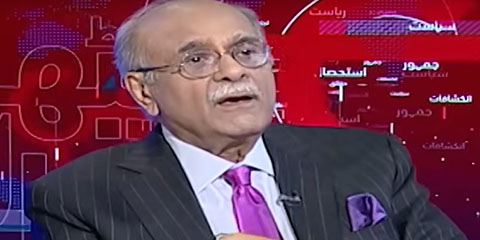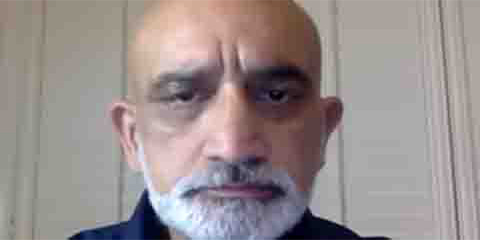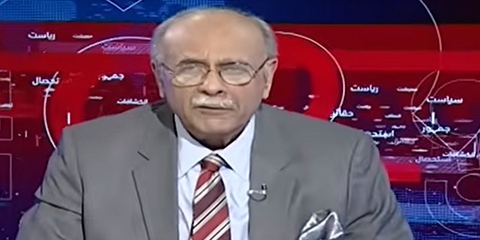'In A Different Realm' offers a philosophical take on cricket's greatest innings
JournalismPakistan.com | Published 7 months ago | Imran Naeem Ahmad
Join our WhatsApp channel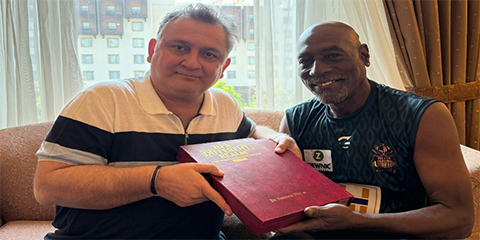
ISLAMABAD—‘In a Different Realm: Story of Quadruple and Triple Centuries 1876–2025’ is not so much a book as it is an invocation, a beckoning into the vaulted minster of cricket's rarest feats. Dr. Nauman Niaz, in the true spirit of a steward rather than a writer, has wrought a work not only of record, but of resplendence. In this work, he does not catalogue centuries; he conjures them, luminous, trembling, alive. For here are not just scores tallied and innings narrated, but epochs exhumed, resurrected with care and with a kind of solemn joy. One finds oneself not just thumbing through a ledger of performances, but walking quietly among legends, each name a word, each knock a kind of music on the breeze of memory.
Dr. Niaz does not offer us a list; he offers us entry into cricket’s most incandescent chapters. The game, as he sees it, is not confined to cricket. It is, instead, a theatre of the soul. And when its greatest actors stand tall, those who carved out triples and the exalted few who dared push into quadruple, it becomes something more: a human spirit in elegiac overdrive.
The achievements described here are not simply statistical marvels, but acts of transcendence. For in the realm of the triple century, a batsman does not just perform, he persists. And in the realm of the quadruple, he ascends. These are not men only playing a game; they are artisans bending time, sculpting permanence from passage, rendering themselves myth.
There is in Dr. Niaz’s prose the cadence of the learned man, yes, but also the gentleness of one who has loved the game not from the outside rail, but from within the pulse of its living rhythm. A philosopher, yes, and also a craftsman, he shapes his settings not with hyperbole but with the brush of understanding, the clarity of context, and a whispering kind of reverence.
As the official historian of Pakistan cricket, Dr. Niaz bears a distinction few can rival. His earlier works — The Fluctuating Fortunes, the Official History of Pakistan Cricket, Pakistan Cricket: The Story of Betrayal, Collector’s Eye, Cricket Witness, and others are testaments not only to his erudition but to his unwavering fidelity to cricket’s true essence. He has written of it not only as a correspondent, commentator, and analyst, but as a man who listens to what the game does not always say aloud.
With In a Different Realm, he goes higher still, threading through cricket’s most luminous innings with an insight that is as inventive as it is intimate. In his telling, the ephemeral becomes the eternal. The fleeting moment becomes a monument. And the game, at its purest, becomes poetry once more.
There is, in the words of Dr. Nauman Niaz, a peculiar enchantment, an alchemy of memory and imagination that stirs the dust of time into something alive. His sentences do not only inform; they illuminate. The past, in his hands, is not static but breathing, as if the sepia shadows of cricket's archives were themselves reawakened by his pen.
In In A Different Realm: Story of Quadruple and Triple Centuries 1876–2025, Dr. Niaz is not just compiling history; he is summoning it. One can almost hear the gentle rustle of applause at The Oval in April 1930, when Andrew Sandham recorded his name into eternity with the first-ever triple century in Test cricket — 325 inspirational, dogged, audacious runs against the West Indies. It is not only the feat that Dr. Niaz recounts, but the feeling, the air, the atmosphere, the very murmur of history folding into a summer’s day.
This, perhaps, is his singular gift: to render cricket’s grandest achievements not as entries in a ledger, but as moments suspended in amber, cinematic, sensorial, richly human. He writes as one who might well have sat in the stands, his gaze fixed, his notes trembling with the awe of something transcendent.
The journey through In A Different Realm is not so much a read as it is a pilgrimage. One begins with Sandham, of course, the pioneer and proceeds to the sweeping artistry of Walter Hammond’s 336 not out against New Zealand in 1933, where power met poise with uncanny harmony. And then, naturally, there is the game’s eternal bard, Sir Donald Bradman. His 334 at Leeds, the 304 that followed, and the colossal 452 not out in first-class cricket, they are not just milestones but testaments. They speak, not only of numbers, but of the rare altitude where genius resides alone, unchallenged.
Yet Dr. Niaz’s gaze is not content with celebration alone. He asks gently, insistently what does greatness truly mean? What inner fire compels a batsman to persist across sessions, hours, even days? What does it take to not merely succeed, but to elevate the very idea of batting into something bordering on the sublime? His is a philosophical inquiry, each chapter a meditation on temperament, toil, and the tantalising alchemy of talent and will. A quadruple century, in this realm, is no longer just a score; it is a spiritual exertion, a test of the human capacity to endure, to transcend, to dream.
From Len Hutton’s stoic 364 against Australia in 1938, a masterclass in restraint and technique, to Lawrence Rowe’s incandescent 302 against England in 1973-74, Dr. Niaz maps out a lineage of brilliance. He speaks of Brian Charles Lara not just as a batsman, but as a visionary, his 400 not out in Tests and the ethereal 501 not out in first-class cricket are presented not as records, but as symphonies, composed in the key of impossible.
Yet this book is more than a chronicle of the majestic. It is, at heart, a celebration of the indomitable spirit that cricket evokes. The marathon innings of Hanif Mohammad, 337 of monastic defiance; the imperiousness of Sir Garfield Sobers’ 365 not out; the uninhibited genius of Virender Sehwag and the thunderous power of Chris Gayle, all of them rise from the page, not as statistics, but as sagas of will, wit, and wondrous audacity.
Dr. Niaz’s genius lies not only in his encyclopaedic knowledge nor even in his stewardship of one of the world’s largest personal collections of cricket memorabilia but in his unique synthesis of history, philosophy, and deeply personal passion. He writes not simply as an archivist, but as a witness, a man who has inhabited the game, absorbed its flows, and come to understand its silences as much as its spectacle.
His words honour not just the deeds, but the dreamers behind them. He captures the flicker of artistry in motion, the drama of the long vigil, and the fleeting instant in which a mortal batsman becomes, however briefly, something more. In In A Different Realm, cricket is not simply described, it is understood. And in that understanding, it becomes, once again, what it has always been at its noblest: an art form, a pilgrimage, and for those willing to look deeply enough, a philosophy in motion.
In A Different Realm – Story of Quadruple & Triple Centuries 1876–2025 is not only a book. It is a sanctuary of cricketing memories, built with the architect’s eye for detail and the philosopher’s yearning for permanence. Bound in dignity, 535 pages printed on sumptuous 110gm art paper, encased in a hard cover with an embossed dust wrapper that breathes elegance, this is an edition to be held with reverence, as one might cradle a relic from a game both ethereal and enduring. Its rarity, only 500 standard copies and 50 hand-numbered Deluxe Editions, each bearing the author’s signature, lends it an air of sanctity. This is no volume for casual reading; it is a companion for those who have heard, deep within themselves, the old leather sound against willow and the hushed awe that trails a man destined to rewrite what we deem possible.
Dr. Nauman Niaz, in his inimitable style, does not just recount the innings, he seems to conjure them. His language is of a high and romantic tier, yet never loses its anchor in clarity. His eight-page eulogy to Brian Charles Lara, cricket’s master dramatist is a case in point. It is as if Lara’s 400 not out in Antigua, his volcanic 501 not out at Edgbaston, and that seductive 375 against England have not been written, but resummoned. Within these pages, the innings breathe once more; the reader hears the rhymes of the crowd, feels the warmth of West Indies’ twilight, and watches the flourish of the bat as if witnessing the event in person.
Each innings beyond 350, every triple and quadruple hundred ever sculpted in Test or first-class cricket until early 2025, is described with a precision that borders on the devotional. It is as though Dr. Niaz had been seated at the fence for each of them, eyes alert, pen ready, spirit aflame. The most recent epic, Tom Banton’s 344 not out for Somerset against Worcestershire in the County Championship arrived, in truth, too late for inclusion. And yet even its absence echoes as a poignant footnote in a narrative that is otherwise exhaustive: Banton’s innings, the 248th triple century in first-class history, now the highest individual score by a Somerset player, stands silently in the wings, acknowledged by history even if not yet by page.
Within the pages, cricket’s canonised greats return in quiet procession. Hanif Mohammad’s 499, that marathon of mind and muscle, still pauses just one run shy of history. Bradman’s 452, rendered with stately clarity. B.B. Nimbalkar’s 443 not out, his innings and his heartbreak both respectfully etched; a man who dared to scale Bradman’s Everest, only to be turned away by the whim of a declaration and a crueler fate: exclusion from India’s Test eleven.
Bill Ponsford’s twin Goliath scores 436 and 429 march forward, the symmetry of greatness intact. Aftab Baloch’s majestic 428, an innings played in the dusk of forgetfulness, for a nation that summoned him twice, six long years apart, and then never again to play in the Tests. Archie MacLaren’s 424, played in 1895 but recounted with such immediacy that the air seems heavy with Edwardian perfume. Sam Northeast’s clinical 410 not out, Graeme Hick’s 405 not out, each lovingly restored, not just as feats but as philosophies, acts of defiance against time, weather, and expectation.
There is something almost ecclesiastical in how Dr. Niaz handles the numbers. They do not clatter like statistics in a ledger. They whisper truths about the human condition, resilience, vision, patience, and the strange burden of genius. His exclusive chapter on the 247 (now 248) triple centuries is not simply a list, but a meditation. What makes a man bat on when the crowd dwindles, when the heat thickens, when his body aches and his mind rebels? What do such innings tell us, not only about the player, but about the nature of art and persistence?
In In A Different Realm, cricket becomes a metaphor, perhaps even a theology. Here, sport is not just entertainment; it is the articulation of man’s highest self, expressed through bat and ball. The book is not only a commemoration of individual brilliance but a profound reflection on the soul of the game. And it is in this that Dr. Niaz’s true genius lies, not just in encyclopaedic knowledge or his astounding collection of memorabilia, but in his rare capacity to fuse the factual with the poetic. He does not write only as a recorder of events. He writes as a witness, quiet, attentive, moved.
This book, in the end, does not speak only of cricket. It speaks of human endeavour, of the lonely artistry required to dream beyond the limits set by others. It is, in every sense, a realm apart.








